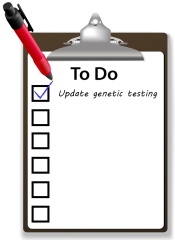Update Your Genetic Testing! A Different Perspective
 Last year I blogged about the importance of updating your preconception carrier screening between pregnancies since new diseases are added to the testing panels pretty often. This is a topic I am very passionate about and always tell my patients, friends, and relatives. More recently, I started to think about the idea of “updating genetic testing” from a different perspective.
Last year I blogged about the importance of updating your preconception carrier screening between pregnancies since new diseases are added to the testing panels pretty often. This is a topic I am very passionate about and always tell my patients, friends, and relatives. More recently, I started to think about the idea of “updating genetic testing” from a different perspective.
When I take family histories in a cancer genetic counseling session, my patients often tell me that a relative had cancer years ago, but he/she did genetic testing and was negative (ie- had normal results). While this information may be helpful, I often tell them that if the genetic testing was done a while ago, they may want to get more testing done since there are now better testing options in the realm of cancer genetics than there were years ago.
“Updating” in the preconception realm generally refers to adding on additional diseases to the panel, and in the cancer and pediatric realms, it can refer to repeating a test that was already done, using a different testing method with a better detection rate, or pursuing genetic testing–for different genes–that was not available at the time.
Let’s look at individuals who have strong personal or family histories of breast/ovarian cancer (“high risk”) as an example. In 1996, ‘sequencing’ (scanning the entire gene) for both BRCA1 and BRCA2 became commercially available through Myriad Genetics, the only BRCA testing lab at the time. At that time, we had already identified that there are three mutations in these genes that are more common among Ashkenazi Jews. Since about 95% of Ashkenazis who have a BRCA mutation will have one of these three mutations, genetic counselors would order ‘multisite’ testing (genetic testing for those three mutations only) for their Ashkenazi high risk patients. As research has advanced, new techniques with higher detection rates were introduced to the market. In 2002, Myriad added a new test to identify 5 large rearrangements in the BRCA genes and in 2006, they added ‘BART’ testing, which looks for large deletions and duplications throughout both genes. With each new technology applied to genetic testing in the same gene, the detection rate has gotten higher. Since then, genetics professionals have recommended that high risk Ashkenazi Jews who test negative for the three common Ashkenazi mutations complete additional genetic testing in the BRCA1 and BRCA2 genes– full sequencing and BART testing. Multisite testing is still used as the first step (and sometimes only step) of testing Ashkenazis, since it is likely that if one has a mutation, it is one of those three. And to take it a step further, high risk individuals who test negative for all known BRCA mutations are being offered genetic testing for panels of many genes known to be associated with breast/ovarian cancer.
So when my patient with a very strong family history of ovarian cancer tells me that her affected sister had BRCA testing in 2001 and had normal results, I feel a slight sense of relief, but I still have concerns that there is a hereditary component to the family’s cancer. I recommend that they come back in for more comprehensive testing, if possible. The same holds true for pediatric or adult patients with genetic concerns that have not been identified.
Just as family histories are dynamic, and people may develop medical issues over time, so too, the availability and breadth of genetic testing is not static and is expanding at a fast pace. I now tell most of my patients to check back with us in a year or two, because more information or more testing may be available at that time. While it may be hard to keep up, a consultation with a genetic counselor who is knowledgeable in the field might be very helpful to you and your family. You can find a genetic counselor near you at www.nsgc.org.
Posted on March 19, 2015, in Uncategorized and tagged BRCA, carrier screening, genetic testing, Myriad Genetics, Program for Jewish Genetic Health. Bookmark the permalink. Leave a comment.

Leave a comment
Comments 0